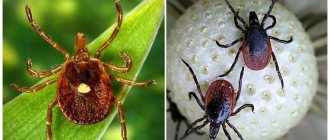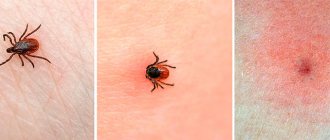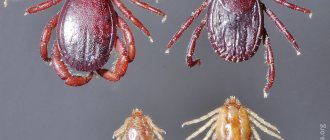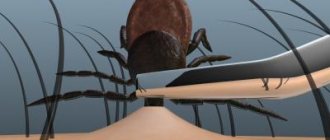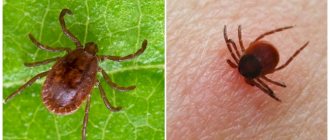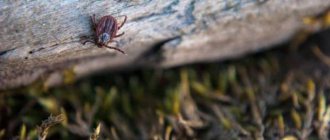Rules for removing a tick
If you find a tick embedded in your body, you must immediately contact a medical facility . If this is not possible, you need to try to remove the tick yourself, following a number of rules:
- do not pick up insects with bare hands;
- do not pull him out by the belly;
- do not pick with a sharp object;
- do not jerk sharply;
- do not burn with fire or cigarette;
- Do not lubricate the wound with gasoline or other similar liquids, which is often done by people.
You cannot pull out a tick with your fingers, as there is a risk of crushing the insect and becoming infected. Lubricating the bite site with some liquid will make the tick fear for itself, which will result in the injection of toxins into the human body.
How to protect yourself from tick bites
Considering what dangerous diseases ixodid ticks are carriers of, it is better to resort to methods of reliable protection in advance.
Simple precautions will help against tick attacks:
- Closed and buttoned clothing tucked into shoes;
- Treatment with repellents that repel bloodsuckers.
For your information! When the risk of catching a tick is high due to the field of activity, you can resort to vaccination against encephalitis to avoid dangerous bites.
Removing a tick using tweezers or thread
It is important to take the procedure as carefully as possible. To pull out the bloodsucker, you can use ordinary threads. A loop is made from such a thread, which is carefully draped over the tick. When the loop is located close to the insect's proboscis, you need to tighten the knot and, without much effort, gradually pull the thread perpendicular to the skin. If you gently and gradually pull without jerking, the tick may come off.
You can also use tweezers to pull out the tick, with the help of which the insect is captured between the head and the human body. It is important to control not to grab the insect by the abdomen, as this increases the risk of crushing it. The tick is pulled out gradually, by slowly pulling around the axis. If successful, the tick will be completely pulled out after 1 – 3 turns.
How to remove a tick
If a person is bitten by a tick, it should be removed quickly, because The longer he is in contact with a person, the higher the risk of contracting dangerous infectious pathologies. It is necessary to remove the parasite from any place on the body, strictly following the technique to prevent the body from being torn off from the head. The parasite must be twisted out and not torn off, since it is deeply and tightly sucked to the skin with the help of a proboscis with processes that hold it.
You can remove a tick at home with your hands, using a thread, tweezers, a syringe or special devices (Tick Twister, Anti-Tick, Nippes), which are available in pharmacies. Such tools resemble a hook or tweezers, but have a special modified shape to make it easier to remove the parasite. It is recommended to take these devices with you when going outdoors.
- What diagnostic procedures are included in the compulsory medical insurance policy?
- 4 ways to get a mortgage without a down payment
- When does the statute of limitations expire for fines for an offense?
Tweezers
One of the most popular tick removal tools, Nippes, helps to grab the insect as tightly as possible and close to the skin, which prevents it from tearing. This is an important advantage, since the remaining part of the skin is a source of pathogens that the parasite carries. The disadvantage of using tweezers is the risk of skin damage if used incorrectly.
Nippes should be used as follows: grab the arthropod between the teeth of the tool, turn it counterclockwise, slightly pulling it towards you. After removing the parasite, treat the suction area with iodine or alcohol. For using regular tweezers, there are the following recommendations:
- Using tweezers, grab the insect's head at the very base, remove it with rotational movements, the parasite should twist out without effort.
- It is better to place the instrument parallel to the skin.
- After removal, lubricate the skin with an antiseptic.
Hands
The disadvantage of removing the parasite by hand is the high probability of crushing the insect and tearing its body, which can provoke infection with encephalitis, so this method is considered the most undesirable. The advantage of removing an insect by hand is that there is no need to use special or improvised tools. You should remove the parasite with your fingers like this:
- Treat your hands and skin around the bite with an antiseptic.
- It is recommended to wear disposable gloves or wrap your hands with gauze or a bandage.
- Grasp the tick at the junction of the body and the head as close to the skin as possible.
- Using a few counterclockwise rotations, slowly remove the insect.
- Treat the affected area with an antiseptic; it is recommended to place the insect in a plastic container and submit it to a laboratory for examination. After the procedure, you should wash your hands with soap.
Thread
One of the easiest methods for removing a tick at home is to extract it with a thread. Among the advantages are its availability and speed. A significant disadvantage of thread removal is the high risk of incomplete extraction of the parasite. The sequence of actions during the procedure is as follows:
- Lightly press your fingers onto the skin near the attached insect.
- Take a thread (preferably synthetic, because it is stronger) 20-30 cm long, make a small loop in the middle.
- Place the middle of the loop on the skin so that the parasite gets into it.
- Tighten the loop tightly into a knot, connect both ends of the thread into one and twist it counterclockwise with your fingers.
- Once the thread is tightly twisted, pull it towards you.
- Treat the skin with iodine or alcohol.
- Fallopian tube laparoscopy
- How to get property tax benefits for pre-retirees
- What products should and should not be bought during quarantine?
Using oil
Removing ticks from a person using oil involves cutting off the access of oxygen to the insect, which forces it to detach itself. The advantage of the method is that there is no risk of damage to the bite site or the body of the parasite, but the disadvantage is that it is often ineffective. Experts believe that due to the lack of oxygen, the insect begins to inject large amounts of saliva, which may contain infection, increasing the risk of infection. Removing a tick using oil should be done as follows:
- Fill the bite area with sunflower oil or any other vegetable oil. Sometimes it is acceptable to use a rich cream.
- Once the tick detaches from the skin, destroy it.
- Treat the wound with alcohol or antiseptic.
Syringe removal
The parasite can be removed using a disposable syringe without a needle. The advantage of this method is its simplicity, but the disadvantage is the high probability of tearing off the head of the tick and its incomplete removal from the skin. Removing the parasite using a syringe should be done as follows:
- Treat the area around the attached insect with alcohol, cologne or antiseptic.
- Remove the syringe from its packaging and slide its plunger down.
- Press the syringe to the surface of the skin so that the parasite is completely hidden in the “nose”.
- Slowly pull the plunger up.
- After the insect separates from the skin, wipe the wound with an antiseptic again.
A special device - “twister”
Today it is possible to purchase a special device - a twister. The device does not allow squeezing the tick, which distinguishes it from tweezers and minimizes the risk of infection. Externally, the twister is similar to a small nail puller, but its dimensions can be different, taking into account the size of the plier. Using a twister, the tick is grabbed from the side and pulled up with a little effort.
Prevention measures
You can only get rid of a tick in a medical facility. But you can prevent a dangerous situation yourself. The main preventive measures are to maintain immunity, as well as correct behavior when walking in the park or forest. To reduce the likelihood of ear mites infestation, you should follow simple recommendations:
- choose light-colored clothing for walks in nature and arthropod habitats;
- trousers must be tucked into socks or boots;
- You need to wear a hood or headdress on your head;
- tie long hair with an elastic band;
- treat clothing with parasite repellents;
- after a walk, inspect shoes and clothes, open areas of the body;
- regularly carry out wet cleaning of premises;
- monitor your health;
- lead an active lifestyle, play sports;
- follow a daily routine, sleep at least 8 hours;
- eliminate bad habits;
- master emotion control techniques that neutralize stressful conditions.
Pulling out a tick with a syringe
There is another household method for removing a tick. It involves using a knife and a regular medical syringe, preferably an insulin one, but a 2 cm3 capacity is also suitable. The procedure is quite simple to implement and anyone can perform it. Using a knife, cut off the end of the syringe along with the needle. It is important to make the cut as smooth as possible. The finished product is tightly applied to the site of tick suction and the air is pumped out of the syringe. The vacuum formed in the resulting capsule should push the bloodsucker out of the wound it created. This method allows for the formation of a small bruise, but these consequences are disproportionate to the risk of contracting a disease dangerous to health.
Why are tick bites dangerous?
Ticks belong to the arachnids; at the moment, parasitic forms of ixodid ticks are represented by 650 species, almost all are bloodsuckers and carriers of diseases dangerous to human health and life:
- tick-borne borreliosis;
- tick-borne encephalitis.
Important! You may not feel a tick bite, because it is painless for humans and animals! The parasite, penetrating into the skin layers, injects saliva, which has analgesic properties.
Therefore, the sooner an attached parasite is detected on the body, the less the infectious agent will enter the bloodstream with its saliva. To do this, you should carefully examine the entire body after a walk in the forest, park, to the river, after a trip out of town, and urgently remove the detected tick, but carefully and following the rules to minimize harm to health!
Even if the tick turns out to be free of infection, the very fact of the bite also carries the threat of infection and suppuration of the place where it was attached. That's why you need to learn how to quickly and safely remove a bloodsucker that has embedded itself in the skin.
Mite on human skin
Do I need to use oil?
There is a fairly widespread opinion in society that when the bite area is lubricated with oil, the tick falls off on its own. This opinion is not only wrong, but can also be harmful. Oil cannot be used for these purposes for the following reasons:
- Tick breathing occurs through the back, the oil on which will help the tick to suffocate. The dead insect will remain in the body and will be difficult to remove.
- The oil will frighten the tick and it will splash its dangerous substances into the body. In this case, infection can hardly be avoided.
Methods for removing ticks from humans
Ticks are a species of arthropod that is one of the oldest living on the planet.
All species completely lack vision, but as compensation, their sense of smell is extremely well developed, which allows ticks to easily find food and navigate in space.
Basic rules for tick removal
The main ways in which a parasite can be removed will be discussed in detail a little later; below are the most important rules that must be followed when using any tick removal technique:
- For the removal procedure, use only a sterile instrument that must be pre-treated.
- Carry out the entire procedure wearing disposable protective gloves.
- Removing the parasite with bare hands is allowed only in the most extreme cases, when there is no other option. This is due both to the risk of infection and to the fact that during such an operation the tick will most likely be torn and crushed, which increases the risk of infection if it has been infected. This can happen due to the contact of substances with the virus on the skin or directly into an open wound.
- Regardless of the chosen removal method, you must remain calm and avoid any haste or sudden movements, since careless removal can aggravate the problem.
- Carefully examine the remaining wound after the tick is removed, as you need to make sure that there is no arthropod head or severed proboscis left in it. They are quite small, so extreme care is required and the use of a magnifying glass is recommended.
- The fact of a bite does not mean that infection has occurred with any dangerous disease. However, even if the parasite was successfully removed on your own, it is important to seek professional medical advice.
Removal methods
Below we discuss various of the most popular and common methods for removing an attached parasite. Any method requires a careful and careful approach; if you are not sure that everything will be done correctly, then the most rational solution would be to turn to specialists for urgent medical help.
Twisting
A bitten tick should not be pulled out; instead, a twisting motion must be made, and this option is the most recommended way to remove it. This procedure is carried out as follows:
- Using disinfected curved tweezers, grab the body of the tick; this must be done as close to the bite site as possible. At the same time, you need to grab it carefully and not squeeze it in order to prevent the death of the parasite.
- Pull lightly over the top, but without sudden movements or attempts to pull it out.
- Simultaneously with stretching upward, begin to make rotational movements. Different people recommend twisting the tick exclusively clockwise or counterclockwise, but in reality there is no fundamental difference.
- If 1-3 turns have already been made, but it is not noticeable that the bitten tick is beginning to succumb, additional treatment with Vaseline is required, which will facilitate the process. Perform a few more revolutions, this time the procedure should be crowned with success.
Use of oil
Removal using oil or kerosene is a well-known technique that has been practiced for quite some time. Despite this, using this method is strictly not recommended for the following reasons:
- Not being able to breathe will kill the parasite.
- The death of the tick will result in it spitting out a small amount of the blood it just drank, mixed with salivary fluid, into the wound. This increases the risk of contracting infectious diseases if the individual has been infected.
- A person will lose the opportunity to provide a specialist with a living specimen for medical research.
Removal with thread
It is recommended to use thread for removal only in situations where it is not possible to use alternative methods.
The method itself is not dangerous, but requires some skill, which makes it difficult. The process itself can be implemented by adhering to the following algorithm of actions:
- Choose a lace with a small diameter or a thread with a dense structure.
- Make a small loop that goes over the body of the parasite.
- Place the loop so that it is located as close as possible to the bite site.
- The noose should not be tightened too much so as not to kill the biting individual.
- Without sudden movements, begin to lightly tug on the thread or cord, while at the same time making smooth movements from side to side to swing the parasite.
- Continuing to make the described movements, gradually pull the tick out.
Removal using special tools
Relatively recently, a variety of special tools have appeared on the market that were designed and manufactured to eliminate ticks.
All of them have a fairly simple design, so you do not need to have any special knowledge or specific skills to use:
- Special hooks that look like miniature nail pullers. They are used very simply: you need to grab the tick from the side with a tool, and then apply the movements already described, which consist of scrolling and pulling. It is recommended to immediately purchase sets that contain hooks of different sizes, designed for convenient removal of parasites of various sizes. Using such a tool is even safer than removing it with tweezers, since there is no compression of the individual’s body, so there is no excessive secretion of saliva, which reduces the risk of infection.
- Plastic tongs that have a special design designed specifically for removing parasites. This tool is used in the same way as regular tweezers. Models that have a built-in magnifying glass have an advantage. It not only allows for better control of the procedure, but also makes it possible to examine the remaining wound for the presence of detached parts of the parasite.
- Special plates made of metal and having a recess on the working surface that allows you to pick up and pull out the tick. Outwardly, it resembles a small keychain; most manufacturers attach it to a chain, from which a magnifying glass is also suspended.
- Plastic spoons remove parasites on the same principle as plates; only the design of the device has been changed: the presence of a handle and a bucket simplifies the process a little.
- Trix allows you to remove parasites using the same principle as using regular thread. Externally, the device resembles a pen, only on the working part it has a small loop instead of a rod. With its help, the body of the tick is picked up, and the presence of a comfortable handle makes it easy to make rotational movements to pull it out.
How not to remove a tick
All the main methods that allow you to most safely remove the parasite have already been discussed, but various actions that are unacceptable during this process also require additional mention:
- It is prohibited to use any liquids that lead to suffocation of the parasite and its subsequent death. This includes various types of oils, gasoline, kerosene and alcohol.
- Burning, for example, with a lit cigarette or a hot needle is also not allowed. Not only does this increase the risk of infection, but the bite site will be much more uncomfortable, increasing the already significant healing time.
- The use of any type of local anesthetic is prohibited; the reasons for this prohibition are the same as for cauterization or the use of asphyxiating liquids.
- It is not allowed to squeeze the tick's body too much, even if there is no intention of causing any harm to it, as this will increase its salivation.
- When removing a tick, it should be rotated, but not twisted, as this will most likely tear it into several pieces.
- You should not pull the parasite out with your fingers, as this increases the risk of its death, the likelihood of infection or any infection getting into the wound from your hands.
- Even briefly touching the removed parasite is prohibited, since infection can occur even if certain substances come into contact with the skin.
If it was not possible to completely remove the tick
After removing the parasite, the wound must be examined through a magnifying glass to check for the presence of microscopic parts of the mite remaining in it. If they are still found, then you need to do the following:
- Make sure that the discovered element is part of a removed specimen; its head usually looks like a small black dot.
- Disinfect the bite site.
- Disinfect a needle with a small diameter. It is recommended to treat it with alcohol and then additionally with fire.
- Using a cleaned needle, remove the head or proboscis from the wound in the same way as when removing an ordinary splinter.
If no remaining parts of the parasite were found in the wound, but for some reason there is no complete confidence that the tick was completely removed, then it must be placed in a jar and demonstrated to a specialist who will give all the explanations.
This process should not be delayed, since the head that has not been pulled out may become infected and continue to spread the infection through the blood.
In some cases, jaws may remain in the wound, which are quite difficult to notice, but they are not dangerous. The only thing they can lead to is local inflammation that occurs due to the presence of a foreign element, but it will pass without any additional measures.
What to do with a tick after removal
After successful removal of the parasite, additional measures must be taken to eliminate the risk of dangerous infection:
- Collect detailed information about the incident, which should include the date and time of the bite, location of the bite, and the amount of time the tick spent on the skin. The latest information is not always accurate, since the tick can only be detected after some time, but the less it has been in contact with the skin, the lower the likelihood of infection.
- Seek medical help and demonstrate the parasite placed in a container to specialists. Reception of ticks in different localities is carried out by various services, these can be epidemiological centers or specialized laboratories.
- If it was not possible to save the tick for presentation to specialists, then there is nothing to worry about, since if the tests taken give a negative answer for the presence of diseases, the doctor will most likely still prescribe preventive vaccination.
Cautions
There are a number of precautionary measures that, when followed, can help prevent negative consequences:
- During trips to nature, you can use special preparations and products designed to combat ticks. However, before using them, you must carefully read the instructions, since some of them are intended for external application to the skin, while others are strictly prohibited from being used in this way.
- For long-term stops or outdoor recreation, it is better to choose forests consisting mostly of dry pine trees, as well as places with sandy soil or simply no grass.
- Donate blood for analysis after a bite only after a few weeks, since at an earlier stage the diseases carried by these parasites cannot be diagnosed.
- Under no circumstances should you crush ticks or touch them with your bare hands.
Prevention
Since the risk arising from a tick bite is quite high, it is strongly recommended to take a number of preventive measures that will reduce the potential danger:
- When relaxing in nature, use the right clothes: they should be as tight-fitting as possible, a hood or headdress is required, trousers should be tucked into shoes, it is best to wear light-colored clothes for more rapid detection of parasites.
- When relaxing outdoors, periodically inspect for ticks. After returning home, the examination procedure must be entrusted to another person who can examine the most difficult to reach areas, for example, the neck or back.
- Treat the skin with an aerosol with a protective anti-parasitic effect, which will prevent a possible attack by ticks.
- Get vaccinated against tick-borne encephalitis, the disease most often transmitted by these parasites. This measure will allow the body to begin producing its own antibodies, preventing the active development of the disease in the event of infection. Today there is a quick vaccination, as well as a standard one, which must be carried out in the fall or winter.
Tips and tricks
To summarize, we can give a few final recommendations that can help in some cases:
- You should not delay the tick removal procedure; this must be done as quickly as possible after detection. Even if an infected individual was caught, poisoning might not yet have occurred.
- Even in the absence of any side effects, seeking medical help and consulting a specialist are mandatory measures.
- If the tests were negative, but 2-2.5 weeks after the bite a sharp and severe increase in body temperature and severe headaches were recorded, then the person needs urgent professional medical help. In particularly advanced cases, such symptoms can lead to paralysis of some muscle groups or entering a coma.
- During family vacations in nature, it is necessary to teach children about ticks and the threat they pose, as well as inform them about basic safety measures. Accordingly, you yourself also need to avoid visiting potentially dangerous places.
Source
Where to put the tick after removing it?
The extracted insect must be preserved for research to determine if it is infected with infections. Analyzes are done in laboratory conditions, including ours at the EL Clinic.
The methods of removing a tick from the body described above, if the rules for their implementation are followed, allow the insect to remain alive. This is important for the laboratory to accept the bloodsucker for analysis for borelliosis, a tick-borne disease. To deliver the tick to the laboratory, you need to place a piece of fabric or moistened cotton wool on the bottom of the jar, on which the bloodsucker is placed.
Further actions
After removing the parasite, thoroughly wash the suction area with soap, disinfect the bite site, and apply an antiseptic to it. An alternative could be apple cider vinegar, calendula or rosemary infusion. Apply iodine to dry skin. If the temperature rises, inflammation in the contact area and general malaise appear, be sure to consult a doctor and state the date of the bite. All these signs indicate an infection.
Don't worry if there are still black dots in the wound - this is what the tick's biting mechanisms look like and do not cause harm.
The most dangerous substances are contained in the tick body, which remains outside, on the surface. Therefore, there is no need to worry if you are unable to remove the head. It can be pulled out with tweezers, but over time it can fall off on its own. When the head is screwed deep into the skin, then a small abscess may form in this place. When the pus begins to come out, the remains of the parasite will appear on the surface along with it.
After removing the tick, do not throw it away, but send it to a laboratory or infectious diseases hospital for identification testing. This must be done no later than 48 hours after extraction; to do this, place it in a jar with damp cotton wool. A specialist will be able to determine the presence of the virus and the degree of its danger.
After a tick bite, it is advisable to do a blood test, but not earlier than 10 days after contact. This is the most reliable way to determine the presence or absence of tick-borne encephalitis or borreliosis.
